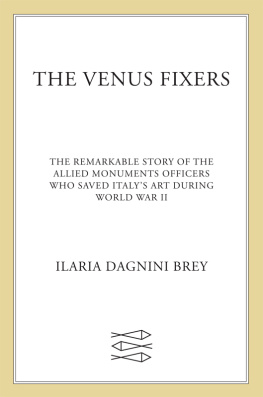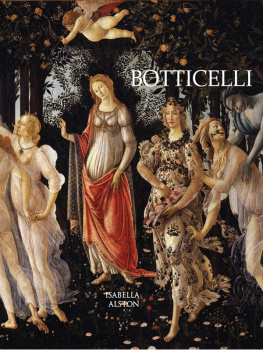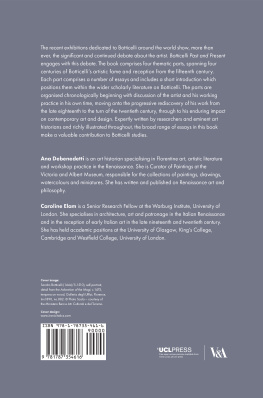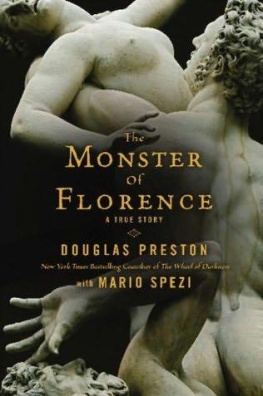The author and publisher have provided this e-book to you for your personal use only. You may not make this e-book publicly available in any way. Copyright infringement is against the law. If you believe the copy of this e-book you are reading infringes on the authors copyright, please notify the publisher at: us.macmillanusa.com/piracy.
It was the wont of the finest spirits in all their actions, through a burning desire for glory, to spare no labour, however grievous, in order to bring their works to that perfection which might render them impressive and marvellous to the whole world; nor could the humble fortunes of many prevent their energies from attaining to the highest rank, whether in order to live in honour or to leave in the ages to come eternal fame for all their rare excellence.
Prologue
Florence looked pale and indistinct to Lt. Benjamin McCartney as he approached it aboard his Martin B-26 Marauder on the morning of March 11, 1944. It wasnt haze that blurred the city skyline on that morning; in fact, as he would later write, the weather was perfect, the visibility unlimited. A sense of impending tragedy seemed to drain the beautiful city of its color in McCartneys eyes as it slowly came into view. He had told his crewhis pilot and friend, Capt. Leonard Ackermann, his co-pilot, Lt. Robert Cooke, and their three enlisted menthat they would soon see Santa Maria del Fiore, Our Lady of the Flower, a cathedral so massive and ambitious it took the Florentines 175 years to erect it; once built, in Giorgio Vasaris words, it dared competition with the heavens. A few yards away stood the baptistery, Dantes beautiful Saint John. Tell me its a real pretty city, the radio gunner Callahan said from the windowless interior of the bomber. It was. In fact, to Lieutenant McCartney, a twenty-eight-year-old Harvard graduate and a well-traveled man who had visited Florence five years before, the city had seemed lovelier and richer in art than any other in the world. Elusive also: seeming to belong to time, not to us, he recalled. Since that trip, a few months before the onset of the war, he had often thought with concern of the citys fragile treasures, but found comfort in the notion that Florences monuments would be its protection and that the tide of war would never reach such a beautiful place. On that March morning, though, it was his job to bomb it.
Its a compliment, the group bombardier told McCartney and his crew on leaving the briefing room that day. The target of the mission was the Campo di Marte marshaling yards, a narrow area dangerously close to the intricate web of old streets and alleys at the heart of Florence. The missions success depended on the technique of precision bombing that had been greatly improved over the course of the war. In North Africa and later in Italy, Lieutenant McCartney and Captain Ackermann had been assigned to more and more difficult raids over harbors, bridges, and large supply depots, with smaller and smaller objectives. At that stage in the war, the American lieutenant could confidently declare that only a few groups of bombers in the world were capable of performing this difficult task.
Sure got a lot of things we cant hit, a bombardier had said during the briefing as he looked at a map of Florence, where white squares marked historic buildings that were to be avoided. Indeed, there probably were more white squares than plain background on that map. But how could Lieutenant McCartney explain, in the few minutes preceding the mission, what it was that made those white markings so untouchable, and what surrounded them almost as precious: the lovely churches and elegant squares, the austere Renaissance palaces that hid dazzling treasures, the small medieval houses overhanging the slow-flowing Arno, the graceful arch of the Ponte Santa Trinita and the tiny goldsmith shops lining the Ponte Vecchio? As he boarded his bomber, McCartneys mind, he wrote later, was burdened by one of the greatest responsibilities of the war, a responsibility felt, but not actually shared, by civilized people all over the world.
How come we are bombing it? Just asking, Callahan said.
After circling above the city, the four planes came over their target and tightened their formation. The bomb bays slowly opened. At about four hundred feet wide and two thousand feet long, the Campo di Marte was a narrow strip to hit. Lieutenant McCartney patiently waited for the freight cars and the rail tracks to come under his crosshairs. He watched his bombs fall in languid, reluctant strings. The mission was successful. As the plane climbed to higher altitudes, the heart of Florence still huddled untouched, if alarmed, around its watchful dome, while the railway tracks were reduced to a tangle of bent steel. These, to answer Callahans question, had connected the Italian war front, which for months had been trapped around the town of Cassino, several hundred miles to the south, to Germany through German-occupied Florence. Reluctantly, the Allied Supreme Command had come to recognize the necessity of bombing Florence, despite its artistic significance and the negative propaganda that such action would very likely provoke. As Lieutenant McCartney sorrowfully understood, despite its loveliness and outward innocence, Florence in March 1944 was an instrument of war.
On that same date, the northern city of Padua was also the target of an Allied bombardment. As the seat of some of the reconstituted Fascist governments ministries, the small medieval town with its old university was a far more obvious and less controversial strategic objective. Just as in Florence, the missions goal was the destruction of the citys marshaling yards. No precision bombing was deemed necessary, though, even if close to the site stood the celebrated fourteenth-century Scrovegni Chapel, its simple exterior of red brick hiding one of the highest achievements of medieval painting, Giottos frescoed stories from the New Testament and from the life of the Virgin Mary. The strike resulted in one of the worst artistic disasters of the Allies Italian campaign. A couple hundred yards separated the chapel with Giottos luminous frescoes from the Gothic Church of the Eremitani; tucked between the two, an old convent housed the Fascist military headquarters. Although the headquarters was not among the bombers objectives that day, for months the parish priest of the Eremitani had pleaded with the Fascist authorities to vacate their seat on account of the grave danger it posed to the two monuments. On March 11, 111 B-17 Flying Fortresses unloaded three hundred tons of explosives. The bombs shook the Scrovegni walls, but Giottos fragile work was undamaged. However, four bombs fell on the Eremitani, destroying its facade and a large part of its roof. To the right of the churchs apse, the Ovetari Chapel, a rare example of early Renaissance fresco painting in northern Italy that had revealed the talent of Andrea Mantegna when first unveiled, was pulverized.
At the other end of the peninsula, in the Apulian town of Lecce, 2nd Lt. Frederick Hartt, a photo interpreter with the Allied forces in the Mediterranean, saw the aerial images of the raid on Padua only hours after the disaster. As he pored over the photos, he quickly located the site of the church and realized the enormous nature of the loss. An art historian in civilian life, the thirty-year-old Hartt could not sleep that night, but paced the streets of Lecce and cried. The story of the Ovetaris decoration, steeped in intrigue and murder, was deeply familiar to him. Mantegna, the son of a carpenter from a village near Padua, was only eighteen and the youngest of six artists when he started painting the chapel in 1448. Work had spanned a decade, and during those years the oldest among them, Giovanni dAlemagna, had died suddenly, Antonio Vivarini had withdrawn from the project, and Nicol Pizolo, a talented artist who was, however, more keen on the use of arms than dedicated to the practice of painting, as Vasari remarked in his Lives of the Painters , was killed in a tavern brawl. The chapels commissioner, Imperatrice Ovetari, proved as formidable a patron as befit her name, Empress. She did not trust, at first, the young artists competence, and called his old master, the Paduan painter and tailor Francesco Squarcione, to judge his work. Envious of his disciples brilliance, Squarcione deemed Andreas figures as hard as stone and lacking the suppleness of flesh. At a later stage, the relentless Donna Imperatrice sued Mantegna for painting only eight of the twelve apostles she expected to see in the scene of the Virgins Assumption. Still, at twenty-three, Mantegna was alone with virtually an entire chapel to fill with painted stories. Perched on the scaffolds, working away on the high walls and vaulted ceiling of the chapel, he brought the innovative language of the Tuscan Renaissance to the provincial town of Padua. While the paint was still fresh on the wall, Marquis Ludovico Gonzaga admired the young artists work so much that he invited him to Mantua, where Andrea would serve as his beloved court painter until his death.












